Gokinjo Boukentai (ごきんじょ冒険隊), released 5/24/1996, developed by ITL, released by Pioneer
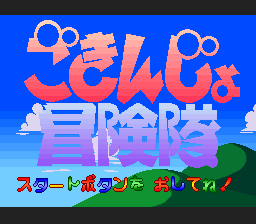
The title of this game might be translated as “Neighborhood Adventure Group” — I think the title is supposed to evoke the idea of a bunch of children pretending to be adventurers. So it’s perhaps not surprising that the main character Mana is a preschooler and the various party members you get throughout the game are other people in her preschool class.
The game occurs over 6 months. In each period, you first do the preschool section during the week, and then have the exploration/event on Sunday.
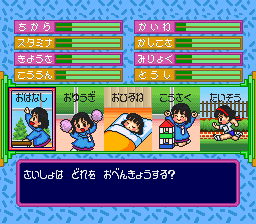
You choose two subjects that Mana will work on during the week — speaking, playing, napping, building, or exercise. You can also pick a friend to work with, and sometimes a third friend will join as well (I’m not completely sure what determines this). Each activity will be done 3 times and has three different results — failure, OK, or success. The better you do the more your stats increase. When one of those dark green bars fills up completely, you get a blue gem that indicates that stat has increased.
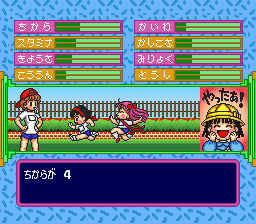
There are no experience levels in the game so this is the only way (other than equipment) to change your stats.
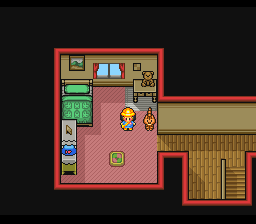
Mana’s mom then wakes her up on Sunday and the adventure part of the game starts. Each Sunday has an event, although some of the events require Mana to have certain stats for them to activate. Sometimes there are alternate events provided — for instance, on 4/28 there is one even if Mana’s strength is above 16, and an alternate event if it is below 16. Other times if you don’t fulfill the requirements there simply will not be an event that day. You can tell this is what happened if there is no cutscene between the training and mom waking you up, and if mom doesn’t say anything beyond her usual wakeup speech. In that case you can just do whatever shopping or talking you want to in the town and then tell mom you’re ready to go to bed. You can also sometimes skip events entirely by going to bed, or later in the game by visiting the “clear man”. You can only skip through some of the days like this, though.
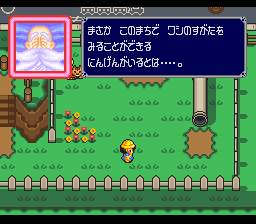
On the first day Mana meets God(!) who then sets up shop in the pipe in that picture; this is where you can save your game and add companions to your party for the day. There are a total of 5 party members aside from Mana, although I believe that 2 of them are optional. Mana’s cat also hangs around randomly and can sometimes do helpful things in battle.
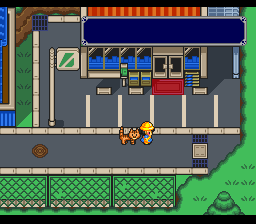
Mana can then wander the town. Apparently 1/3 of the size of the cart is text, and there are a lot of people in the town who frequently change what they say. This is mostly window dressing, though. The town is pretty complicated to navigate, and I would recommend using a map or making your own, noting what the various stores sell and where key people are. The shops that sell the weapons and armor for characters aren’t always immediately evident. They change inventory each month.
Money is relatively limited in the game. Mana will get an allowance from her mom each day, but it’s not that much money. The cat will sometimes return with money, but this is unreliable. You can sell items for money; enemies drop things like Crowns and Iron Scrap that you can trade with some people in town for items that can be used in battle or sold.
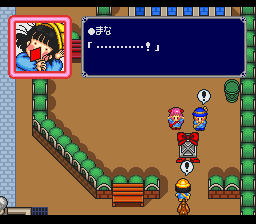
The events frequently deal with Nanako (the pink haired girl) who is the daughter of a rich CEO and bullies everyone else. Other antagonists (or semi-antagonists) are Gojirin, whose underlings remind me of Earthbound.
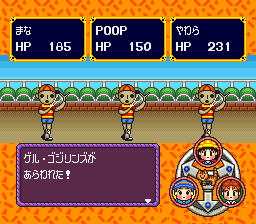
There are also some fantastical elements, such as meeting kappa in a river, and helping ghosts.
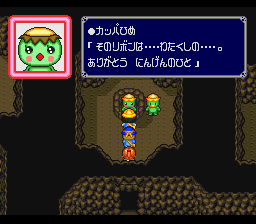
The events always end with Mana’s mom coming to get her, scolding her for being late for dinner — she’s able to find you anywhere.
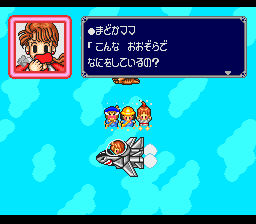
The battle system has some peculiarities. You recover all your HP at the end of each battle. Techniques cost HP to use, so there is some limit on what you can do in that respect.
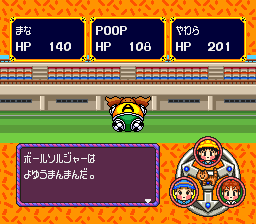
By rotating your formation at the bottom you can change the stats a bit. I found that in general the difficulty level was relatively high, especially at the beginning. If Mana’s HP reaches 0, you get a game over, but God will then take you to train and you will upgrade one of the three main stats (atk, def, spd) and try again. These upgrades go away when you beat the enemy — I believe that if you keep getting game overs the upgrades stack, but I’m not 100% certain about that.
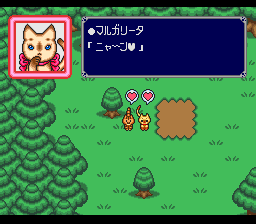
Although most of the game is just foiling Gojirin or Nanako’s mischief, a pattern emerges of people being possessed by some kind of evil spirit that we keep driving out. Eventually that leads to the final boss, who is some sort of embodiment of those negative feelings.
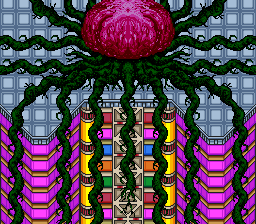
In the end Mana moves away because her father gets a job transfer, but all her friends say goodbye to her as she goes.
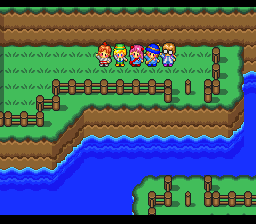
You can then replay the game in V-MAX mode, which doubles the gains you get from the training/school parts and thus makes it much easier to qualify for the events that require certain levels of stat (you can easily qualify for them without V-MAX, though, if you know what they are in advance — the one you have to work the hardest for is Level 4 Conversation by 8/25, but even this can be done without too much trouble.)
On the negative side, the balance can be a bit weird sometimes. I had several instances where enemies surprised me and got the first turn, and killed Mana before I could act. However, given the way the game over works that’s not a huge deal because you’ll come back with better stats and they may not get the surprise attack. Sometimes the hints for where to go next are hard to find or even nonexistent, although being able to skip days means that it’s hard to get completely stuck. There are some interface issues — you can’t see what items do when you’re buying them, which is annoying given the limited money. You can only see what the abilities do from the status menu, not when you’re in battle. It’s a little surprising that in 1996 companies are still not providing basic information like this to the player in a helpful way.
But overall I had fun with the game and it’s definitely worth a play. The cuteness and quirkiness sets it apart from the other RPGs of the era, and there’s a lot you can do and explore in the little town.
I’d really love to give this game a try. Hoping it’s translated someday, as I don’t know if I’ll ever learn enough Japanese to play any rpg from start to end comfortably enough.
That thing you say about having many things to do in the city reminded me of my Jungle Wars 2 playthough when I arrived at the city. There were tons of things to do and explore there as well, specially because the whole city changes radically during the night and day cycle. Wandering at night, I bumped into a night club full of drunk adult people on their mid-life crisis, saying nostalgic things about their student years. Also, you could buy properties and build there, buy cars and ride them, etc. It’s a pity I couldn’t explore it properly due to the language barrier.
This sounds the kind of game that while it might be good, if it’s too long it might overstay it’s welcome, thankful according to a YouTube long play it’s only 6 hours long which is perfect, sadly It doesn’t have any fan translation yet.
I highly doubt it will have a fan translation. Any decent translation will have to retain the childish, cutesy tone of the text, and this is a hard task.
Translating it is easy, retaining the tone is not. And the tone is everything in this game.